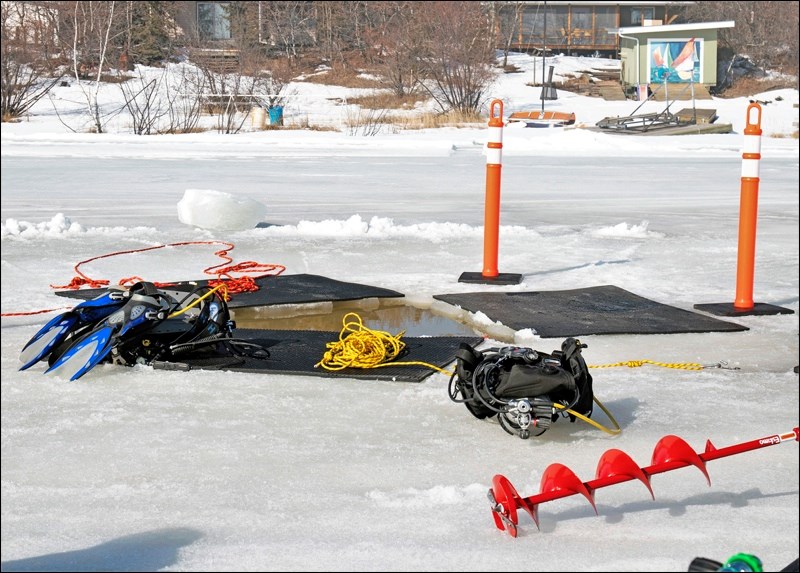Submitted by the Battlefords Scuba Community
Most ice fishermen make a small hole in the ice and drop a line (and maybe a camera) through to catch fish during the six months of a Saskatchewan winter.
But some members of the Battlefords Scuba Community recently switched things up a bit. They cut a big hole in the ice and went through the hole to meet those fish in the water.��
They call it ice diving and it is a great way for dive enthusiasts to keep their submersion quotient up.��
Others call it by names like insanity, craziness and see it as a stupid way to get even colder than usual. It depends upon one’s point of view.
Three of the club divers under the tutelage of Sheldon Funk of Saskatoon completed their certification as ice divers at Atton’s Lake over a weekend that proved to be much more co-operative than the originally scheduled March 1 and 2 dates. They had previously completed a classroom session and a pool session in preparation. The focus of the pool session was buoyancy control, dealing with entanglement (mainly with the tether line), and communications.
The dry suit clad divers make their entry into the frigid waters through a triangular hole (six feet on each side). It is important that their equipment become acclimated to the cold before the divers venture below the ice. To do this they float on the surface with the regulators (breathing devices) submerged for a minute or two.��
They then descend below the ice and explore a world that few get to see. The dives are short for the most part, 10 minutes maximum usually.��
Every precaution is taken to make the diving as safe as possible. The surface of the ice is cleared to make a 20-foot circle around the hole to let light in (and to improve footing) and then concentric circles of fifty feet and one hundred feet radii are cleared through the snow.��
Lines are then cleared from the centre of the hole along the eight major compass headings. The light from these converging lines can guide divers back to the opening. In addition, one diver is tethered on a one hundred foot line held by a tender and anchored into the surface of the ice.��
The two divers of a buddy team are linked by a 10-foot length of line. All lines are fastened to the divers’ gear with locking carabiners. Communications are carried out by signals using the tether lines. For each dive buddy team in the water, there is a safety diver on the surface ready to enter the water at a moment’s notice.
Rubber mats placed around the hole reduce the possibility of slipping on the wet ice.�� Heated tents enable the divers to warm up between dives along with the surface support personnel.�� Hot beverages and food help with warming from the inside out.
Despite popular opinion that says it must be extremely cold under the ice, divers can be quite comfortable. The water temperature at the bottom of Atton’s at the height of summer temperatures is only 5.5 C and on this particular weekend the temperature was about 1 C. The dry suit with its underwear keeps the body warm and the head is protected by a neoprene foam hood. The hands remain the vulnerable spot on the body whether in dry gloves or wet gloves, and for the most part they can endure the 20-minute immersion.
What is the appeal of diving under the ice? There is the thrill of pushing one’s envelope for sure. But the visibility usually is much greater than during the summer months – no boats stirring up the water, no wind or wave action to keep material suspended in the water, and it is too cold for the algae to grow. So rather than the usual 15-foot visibility, there is likely to be 40- to 50-viz (diver jargon).
If there is a snow cover on the ice surface, the light penetration can be reduced considerably, but underwater flashlights can ease that problem. And if there is not much snow cover, on a sunny day, the light penetrating the ice and catching the air bubbles accumulating along the under surface of the ice can make for a spectacular dancing display. And seeing the surface structures and activity from below is quite an experience for those looking upward.
A lot of work goes into getting ready for an ice dive, and this was pointed out frequently by the spectators – a lot of work for a short time in the water. Does it compare to diving the coral reefs of the tropics? Not at all, for it is a different world entirely.
For more information on ice diving, or any scuba diving for that matter, please check out the club’s website at . We love to share our passion with others.
��
��




